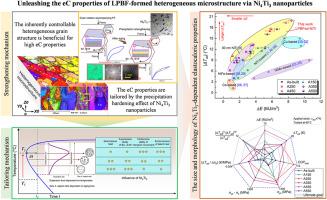Unleashing the elastocaloric cooling potential of 3D-printed NiTi alloy with heterogeneous microstructures and Ni4Ti3 nanoparticles
IF 12.7
1区 材料科学
Q1 ENGINEERING, MULTIDISCIPLINARY
引用次数: 0
Abstract
Toward the development of elastocaloric (eC) refrigeration applications, this study examines how Ni4Ti3 nanoparticles improve the eC properties of laser powder bed-fused (LPBF) NiTi alloys, with a focus on the formation of a NiTi/Ni4Ti3 nanocomposite. The LPBF-produced microstructure offers significant advantages: i) a heterogeneous grain structure that provides complementary benefits—fine grains offer higher deformation resistance while coarse grains initiate phase transformation (PT) earlier, releasing more latent heat; ii) a strong <001>//building direction texture that enhances recoverability. However, these benefits are partially limited by grain boundary slip during PT, leading to lower cooling efficiency and increased energy dissipation in as-built NiTi alloys. To address these issues, Ni4Ti3 nanoparticles are introduced through aging treatment, forming a composite structure that strengthens grain boundaries. Given the challenges of applying severe plastic deformation to 3D-printed components, this approach may offer a more practical solution. The study also reveals that Ni4Ti3 nanoparticles contribute to: 1) reducing Ni content in the matrix, increasing lattice size and enthalpy, which enhances the temperature drop (ΔTad); and 2) promoting R phase formation, which hinders the B2↔B19’ PT, reducing energy dissipation and improving the coefficient of performance (COPmat). The balance of these effects depends on nanoparticle size, with smaller particles (∼5–12 nm) amplifying the second effect, while larger particles (∼130 nm) increase the first effect. At 350 °C aging, the optimized nanocomposite exhibits a maximum COPmat of 15 and ΔTad of 14K, representing a 163 % improvement over the as-built alloy. This work highlights the potential of NiTi composites in 3D-printed eC components.

释放具有异质微结构和 Ni4Ti3 纳米颗粒的 3D 打印镍钛合金的弹性冷却潜力
为了开发弹性制冷(eC)应用,本研究探讨了 Ni4Ti3 纳米粒子如何改善激光粉末床熔化(LPBF)镍钛合金的 eC 特性,重点是镍钛/Ni4Ti3 纳米复合材料的形成。LPBF 生产的微观结构具有以下显著优势:i) 异质晶粒结构提供了互补优势--细晶粒具有更高的抗变形能力,而粗晶粒更早启动相变 (PT),释放出更多潜热;ii) 强<001>//构建方向纹理提高了可回收性。然而,这些优点在一定程度上受到 PT 期间晶界滑移的限制,导致冷却效率降低,坯料镍钛合金的能量耗散增加。为了解决这些问题,通过时效处理引入了 Ni4Ti3 纳米粒子,形成了一种可强化晶界的复合结构。考虑到对 3D 打印部件施加剧烈塑性变形所面临的挑战,这种方法可能会提供一种更实用的解决方案。研究还发现,Ni4Ti3 纳米粒子有助于1)减少基体中的镍含量,增加晶格尺寸和焓,从而提高温降(ΔTad);2)促进 R 相形成,阻碍 B2↔B19' PT,减少能量耗散,提高性能系数(COPmat)。这些效应的平衡取决于纳米颗粒的大小,较小的颗粒(5~12 nm)会放大第二种效应,而较大的颗粒(130 nm)会增加第一种效应。在 350 °C 老化条件下,优化纳米复合材料的最大 COPmat 值为 15,ΔTad 值为 14K,与原合金相比提高了 163%。这项工作凸显了镍钛复合材料在三维打印 eC 组件中的潜力。
本文章由计算机程序翻译,如有差异,请以英文原文为准。
求助全文
约1分钟内获得全文
求助全文
来源期刊

Composites Part B: Engineering
工程技术-材料科学:复合
CiteScore
24.40
自引率
11.50%
发文量
784
审稿时长
21 days
期刊介绍:
Composites Part B: Engineering is a journal that publishes impactful research of high quality on composite materials. This research is supported by fundamental mechanics and materials science and engineering approaches. The targeted research can cover a wide range of length scales, ranging from nano to micro and meso, and even to the full product and structure level. The journal specifically focuses on engineering applications that involve high performance composites. These applications can range from low volume and high cost to high volume and low cost composite development.
The main goal of the journal is to provide a platform for the prompt publication of original and high quality research. The emphasis is on design, development, modeling, validation, and manufacturing of engineering details and concepts. The journal welcomes both basic research papers and proposals for review articles. Authors are encouraged to address challenges across various application areas. These areas include, but are not limited to, aerospace, automotive, and other surface transportation. The journal also covers energy-related applications, with a focus on renewable energy. Other application areas include infrastructure, off-shore and maritime projects, health care technology, and recreational products.
 求助内容:
求助内容: 应助结果提醒方式:
应助结果提醒方式:


